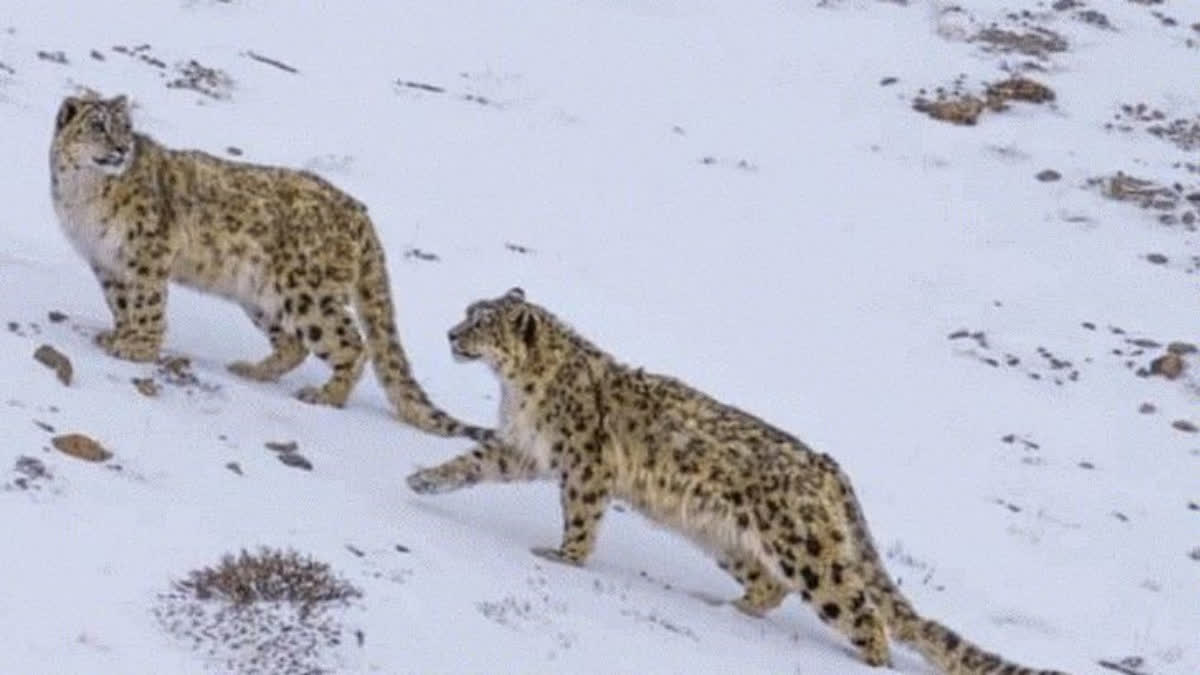Itanagar: Arunachal Pradesh is home to 36 snow leopards, according to a survey. The survey by the Department of Environment, Forests and Climate Change (DoEFCC), in collaboration with the WWF-India was released by Arunachal Pradesh Forest minister Wangki Lowang on Tuesday. The report provides the first-ever scientifically robust estimates of the snow leopard population and density in Arunachal Pradesh. The report provides a baseline of the state of snow leopards in Arunachal Pradesh to establish a long-term monitoring plan for the species.
The snow leopard (Panthera uncia) is the apex predator of the trans-Himalayas. It also has a high significance in the local folklore, culture and traditions of the Himalayan communities that share space with this species. In 2008, the government of India launched a flagship project called the project snow leopard to conserve and safeguard the unique natural heritage of high-altitude wildlife populations and their habitats by promoting conservation through participatory policies and actions. This is a significant recognition that the unique cultures, traditions and livelihoods of the mountain communities are closely linked with these landscapes, and they have a stewardship role to play in conserving them.
Cat species hold a special significance across most tribes of Arunachal Pradesh as totemic symbols of spiritual significance, and often most of these tribes have the highest sanctions (in-kind) if they violate the taboo on hunting carnivores. The high-altitude areas of Arunachal Pradesh have largely remained unexplored from a wildlife research and conservation perspective.
Solitary, almost silent and majestically beautiful, the snow leopard is one of the most enigmatic big cats. It is also one of the most elusive and endangered. Highly adapted to life on the cold, rocky slopes of high Asia, the snow leopard is a master of stealth and camouflage. Very rarely seen by humans, it has come to be known as the 'ghost of the mountains'. It has also become an icon for these breathtaking and critically important landscapes, which house a diverse array of unique high-altitude species and provide critical ecosystem services for hundreds of millions of people.
In India, the snow leopard is found in the Union territories of Ladakh and Jammu and Kashmir, the states of Uttarakhand and Himachal Pradesh in the Western Himalayas and Arunachal Pradesh and Sikkim in the Eastern Himalayas. Even though Arunachal Pradesh has more than 15,000 square kilometre of potential snow leopard habitat, no rigorous assessment of the status of the snow leopards exists so far.
The DoEFCC initiated a pioneering project to assess the population of snow leopards in 2021, the report said. It said the exercise was challenging given that the snow leopard habitat in Arunachal Pradesh, unlike most other places, is not easily accessible, and the terrain is particularly challenging. This is the first study that attempts a robust assessment of the population of snow leopards in the state and does it at a scale that covers the entire potential habitat of the snow leopards. The study used state-of-the-art simulations to develop a robust design for the state-level assessment, followed by a gruelling period of fieldwork when the frontline staff of the state forest department participated with great enthusiasm.
DoEFCC co-opted WWF-India as the technical knowledge partner to design the study, train the staff and execute the fieldwork. As a part of the fieldwork, the department used camera trapping exercises from June 24 to December 9, 2021 covering 115 locations across the state. They also conducted interviews with herders and ex-hunters in 160 locations (hamlets, villages, and grazing camps), to assess state-level snow leopard presence, perceptions, and threats to the species and its habitat.
Over 80 per cent of the interviewees positively confirmed the presence of snow leopards from all the surveyed districts. During the fieldwork, eight individual snow leopards were detected in over 40 snow leopard capture events in 16 different camera traps in Tawang and Bomdila divisions. It identified that the most significant threat to snow leopards is accidental killing/snaring in all the surveyed districts except West Kameng and Tawang, where retaliatory killing is the primary threat, followed by accidental killing/snaring. It was also identified that the development of large-scale infrastructure and free-ranging dogs seriously threatens the wildlife in high-elevation areas of the West Kameng and Tawang districts.



